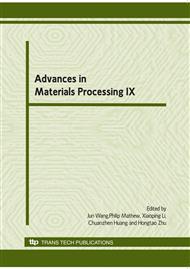p.353
p.359
p.365
p.371
p.376
p.382
p.388
p.394
p.400
Intelligent Monitoring and Estimation of Surface Roughness on CNC Turning
Abstract:
In order to realize an intelligent machine tool, an in-process monitoring system is developed to estimate the in-process surface roughness. The objective of this research is to propose a method to estimate the surface roughness during the in-process cutting by utilizing the in-process monitoring of cutting forces. The proposed in-process surface roughness model is developed based on the experimentally obtained results by employing the exponential function with five factors of the cutting speed, the feed rate, the tool nose radius, the depth of cut, and the cutting force ratio. The multiple regression analysis is utilized to calculate the regression coefficients with the use of the least square method. The prediction interval of the in-process surface roughness model has been also presented to monitor and control the in-process estimated surface roughness at 95% confident level. It is proved by the cutting tests that the proposed and developed in-process surface roughness model can be effectively used to monitor and estimate the in-process surface roughness by utilizing the cutting force ratio with the highly acceptable prediction accuracy achieved.
Info:
Periodical:
Pages:
376-381
Citation:
Online since:
June 2010
Authors:
Keywords:
Price:
Сopyright:
© 2010 Trans Tech Publications Ltd. All Rights Reserved
Share:
Citation:


